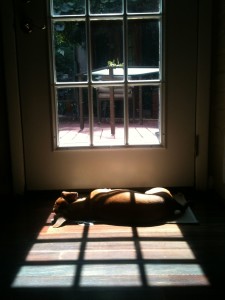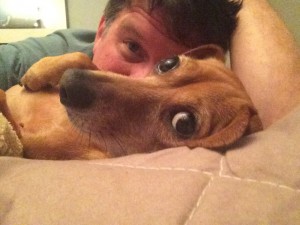We want stuff fast: food, coffee (definitely coffee), replies to our emails – the faster the better, right? We want to feel better quickly, advance in our careers quickly, stop being sad and get happy – quickly. We’re in a hurry, zipping, weaving, taking short cuts and cutting people off (not you, I know). But here’s the thing about fast. It’s often sloppy. And a lot of the time it actually slows us down when we hurry up.
Here’s my advice, especially when it comes to working with your dog: Slow down. It will help you speed up your training. That’s a great paradox, isn’t it? It’s sort of like jumbo shrimp but, it’s true. If we dial back the rush and get out of our own way (and our dog’s way) we can actually step up the rate of our success.
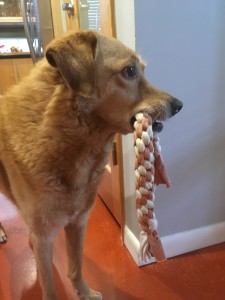 We’re all guilty of this (me too). We want to teach a task, let’s say coming when called, and it feels like we’re on some sort of time crunch. So, we do two or three reps with our dog in the house and we get bored. Let’s go to the dog park and practice there. We call and call and call and she doesn’t come. Then we get frustrated. This isn’t working. We blame the dog. But, it’s not her fault. We’re rushing.
We’re all guilty of this (me too). We want to teach a task, let’s say coming when called, and it feels like we’re on some sort of time crunch. So, we do two or three reps with our dog in the house and we get bored. Let’s go to the dog park and practice there. We call and call and call and she doesn’t come. Then we get frustrated. This isn’t working. We blame the dog. But, it’s not her fault. We’re rushing.
Here’s how you really speed things up. Break down all your training goals into small steps. For coming when called we may begin by reinforcing our dog for looking when we call her name – just a look (click/treat). Then we build to her coming short distances inside – then longer distances – then out in the back yard – and so on.
We do this when we teach our dog to lie on a mat. We reinforce her for looking at it, then stepping towards it, then stepping on it, then sitting, then lying. Those are all small steps with clicks and treats along the way. We could actually break down the steps even smaller to progress even quicker. That’s how you can train your dog to lie on mat in a matter of days – sometimes faster.
Breaking the task down may seem cumbersome and even boring. But, don’t be fooled. The key is to keep the process moving forward. As our dog masters each small task, we advance to the next one. Let’s not go too slowly and get stuck reinforcing one step for too long. But, let’s not move too fast and leave our dog in the dust either. Better to stay mindful and keep our dog (and ourselves) engaged and progressing. We can move very quickly that way.
Okay, but what if training falls a part and our dog just isn’t getting it? Tap the breaks. Go back to an earlier easy step at which your dog was successful. Jump start the process. Show her how to win again. Motor forward. Before long you’re building some speed once more.
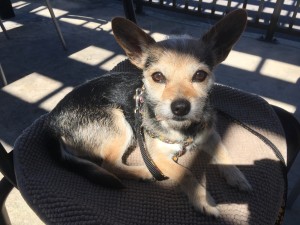 Breaking things down as a key to winning is not a new concept. Trainer educator Laura Van Arendonk-Baugh (no relation) talks about it a great deal in her book, Fired Up Frantic and Freaked Out. Clicker training is all about teaching skills quickly (sometimes very quickly) in incremental steps. It works well for us humans too. Psychologist Angela Duckworth researches grit, that human quality that keeps us passionate and persistent in our life goals. She’s found that the grittiest of very successful people split their big goals in to many smaller ones. They thin-slice tasks and push speedily towards their own personal finish lines. I highly recommend Duckworth’s book, Grit: the Power of Passion and Perseverance.
Breaking things down as a key to winning is not a new concept. Trainer educator Laura Van Arendonk-Baugh (no relation) talks about it a great deal in her book, Fired Up Frantic and Freaked Out. Clicker training is all about teaching skills quickly (sometimes very quickly) in incremental steps. It works well for us humans too. Psychologist Angela Duckworth researches grit, that human quality that keeps us passionate and persistent in our life goals. She’s found that the grittiest of very successful people split their big goals in to many smaller ones. They thin-slice tasks and push speedily towards their own personal finish lines. I highly recommend Duckworth’s book, Grit: the Power of Passion and Perseverance.
Now a quick note about urgent dog behavior matters, the ones in which people and other dogs might be in danger. Dog who bite need to stop biting, right now. The same is true of dogs who might be a danger to themselves. We can take action to prevent dangerous behavior that can stem the problem right away. Baby gates, closed doors, leashes, and such all play a role. That kind of management of our dog’s environment is, in fact, essential. It’s an quick fix but, still, it’s not sufficient.
Training and behavior change plans complete the story. Can we teach our dogs to behave differently (better)? Yes, of course. Can we do it quickly? Yes, if we’re willing to slow down. When create a plan that breaks our big objective down into smaller ones, we speed up the process – one task at a time – one win at a time. All the while we are narrowing the distance to our goal, faster than we might have ever imagined.
Michael Baugh CDBC CPDT-KSA teaches dog training in Houston, TX. He specializes in behavior problems related to fear and aggression.

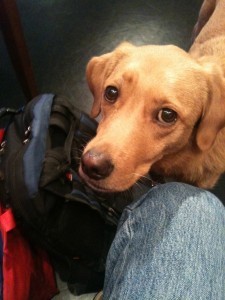
 Breathe in the space in between. So often we are caught in the illusion that learning and teaching are only things that happen in “sessions.” Take just a second, or a minute, or two. Then take a breath. Look at your dog. Is she looking back? Raise your eyebrows and say “hello.” It’s such a powerful moment. If she comes to you, pet her. Let everything else that is happening fall away (It will be there when you get back). Breathe through this experience with your dog.
Breathe in the space in between. So often we are caught in the illusion that learning and teaching are only things that happen in “sessions.” Take just a second, or a minute, or two. Then take a breath. Look at your dog. Is she looking back? Raise your eyebrows and say “hello.” It’s such a powerful moment. If she comes to you, pet her. Let everything else that is happening fall away (It will be there when you get back). Breathe through this experience with your dog.